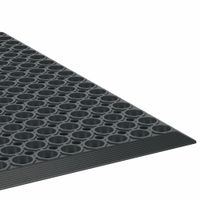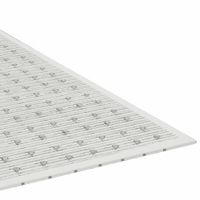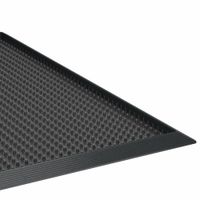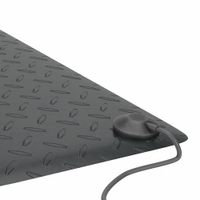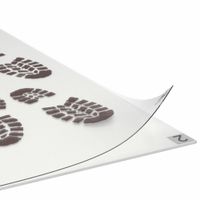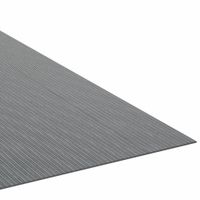Call +(254) 703 030 000 / 751 483 999 / 721 704 777
.....Read More
Frequently Asked Questions
What are the benefits of using floor mats in the workplace?
Floor mats in the workplace offer numerous benefits that enhance safety, comfort, and productivity. Firstly, they significantly reduce the risk of slips, trips, and falls by providing a stable, non-slip surface, especially in areas prone to moisture or spills. This is crucial in maintaining a safe working environment and minimizing workplace injuries.
Secondly, floor mats contribute to ergonomic comfort. Anti-fatigue mats, in particular, are designed to reduce strain on employees who stand for extended periods. These mats promote better posture, reduce foot and lower limb discomfort, and can lead to increased productivity and reduced absenteeism due to musculoskeletal issues.
Additionally, floor mats help in maintaining cleanliness and hygiene. Entrance mats trap dirt, dust, and moisture from shoes, preventing them from being tracked into the workplace. This not only keeps the premises clean but also reduces cleaning costs and the wear and tear on flooring surfaces.
Floor mats also play a role in noise reduction. In busy environments, mats can absorb sound, contributing to a quieter and more focused work atmosphere. This can be particularly beneficial in open-plan offices or industrial settings.
Moreover, floor mats can be customized with company logos or safety messages, enhancing brand visibility and reinforcing safety protocols. This can contribute to a cohesive corporate image and promote a culture of safety.
Lastly, using floor mats is an environmentally friendly choice when opting for mats made from recycled materials. This supports sustainability initiatives and can improve the company’s environmental footprint.
In summary, floor mats are a cost-effective solution that enhances safety, comfort, cleanliness, and aesthetics in the workplace, ultimately contributing to a more efficient and pleasant working environment.
How do antifatigue mats improve worker comfort?
Antifatigue mats improve worker comfort by providing a cushioned surface that reduces the strain on the body caused by prolonged standing. These mats are designed to encourage subtle movements in the leg and calf muscles, which enhances blood circulation and reduces the risk of fatigue. By promoting micro-movements, antifatigue mats help prevent the pooling of blood in the lower extremities, which can lead to discomfort and swelling.
The cushioning effect of antifatigue mats helps to distribute body weight more evenly, reducing pressure on the feet, legs, and lower back. This alleviation of pressure points minimizes the risk of developing musculoskeletal disorders, which are common in occupations that require long periods of standing. The mats also provide insulation against cold floors, which can contribute to discomfort and fatigue.
Additionally, antifatigue mats can improve posture by encouraging a more natural stance, reducing the likelihood of slouching or adopting awkward positions that can lead to strain. The improved posture and reduced strain on the body contribute to a decrease in overall fatigue, allowing workers to maintain higher energy levels and productivity throughout their shifts.
The surface texture of antifatigue mats often provides slip resistance, enhancing safety by reducing the risk of slips and falls. This added safety feature contributes to a more secure and comfortable working environment.
Overall, antifatigue mats are a simple yet effective solution for enhancing worker comfort, reducing fatigue, and promoting a healthier work environment, particularly in settings where standing for extended periods is unavoidable.
What types of floor mats are best for preventing slips and falls?
The best types of floor mats for preventing slips and falls are those designed with high-traction surfaces and materials that provide stability and grip. Here are some effective options:
1. **Rubber Mats**: These are highly durable and provide excellent traction, even when wet. They are ideal for areas prone to moisture, such as kitchens, bathrooms, and entryways.
2. **Anti-Fatigue Mats**: While primarily designed to reduce fatigue for people standing for long periods, these mats often have non-slip surfaces that help prevent slips and falls. They are suitable for workplaces like factories and kitchens.
3. **Carpet Mats with Non-Slip Backing**: These mats offer a softer surface and are often used in residential settings. The non-slip backing ensures they stay in place, reducing the risk of tripping.
4. **Vinyl Mats**: Known for their durability and ease of cleaning, vinyl mats often have textured surfaces that enhance grip. They are suitable for high-traffic areas.
5. **Gel Mats**: These provide cushioning and are often used in kitchens. They have non-slip surfaces and backing to prevent movement.
6. **Interlocking Floor Tiles**: Made from rubber or foam, these tiles can be used to cover larger areas. They provide a stable, slip-resistant surface and are often used in gyms and play areas.
7. **Drainage Mats**: Designed for wet environments, these mats have holes that allow liquids to pass through, keeping the surface dry and slip-resistant. They are ideal for kitchens, bars, and pool areas.
When selecting a mat, consider the environment, the level of foot traffic, and the potential for exposure to moisture or oils. Regular maintenance, such as cleaning and ensuring the mats are properly positioned, is also crucial for maximizing their effectiveness in preventing slips and falls.
How do entrance mats help in maintaining cleanliness?
Entrance mats play a crucial role in maintaining cleanliness by acting as the first line of defense against dirt, moisture, and debris entering a building. They are strategically placed at entry points to capture contaminants from footwear, reducing the amount of dirt tracked inside. This not only keeps floors cleaner but also minimizes the need for frequent cleaning, saving time and resources.
The effectiveness of entrance mats lies in their design and material. Scraper mats, often placed outside, have coarse surfaces that remove larger particles like mud and gravel. Inside, wiper mats absorb moisture and finer dirt, preventing slippery floors and reducing the risk of accidents. By trapping moisture, these mats also help in maintaining indoor air quality by reducing humidity levels.
Moreover, entrance mats protect flooring from wear and tear caused by foot traffic, extending the life of interior surfaces. This is particularly important in high-traffic areas where floors are prone to damage. By preserving the condition of floors, mats contribute to a cleaner and more aesthetically pleasing environment.
Entrance mats also play a role in enhancing hygiene. By reducing the amount of dirt and bacteria brought indoors, they help in maintaining a healthier environment, which is especially important in places like hospitals and schools. Additionally, many mats are designed to be antimicrobial, further preventing the spread of germs.
In summary, entrance mats are an essential component of a comprehensive cleaning strategy. They effectively reduce the ingress of dirt and moisture, protect flooring, enhance safety, and contribute to a healthier indoor environment, all of which are vital for maintaining cleanliness in any facility.
What is the purpose of sticky-surface floor mats?
Sticky-surface floor mats, also known as tacky mats or adhesive mats, serve the primary purpose of controlling contamination in clean environments. These mats are strategically placed at the entrances of cleanrooms, laboratories, hospitals, and other controlled environments to capture dirt, dust, and other particulates from the soles of shoes and wheels of carts. By doing so, they help maintain the cleanliness and sterility of these sensitive areas.
The mats are composed of multiple layers of adhesive-coated polyethylene sheets. As individuals or equipment pass over the mat, the sticky surface traps contaminants, preventing them from being carried into the clean area. Once the top layer becomes saturated with debris, it can be peeled away to reveal a fresh adhesive layer underneath, ensuring continuous effectiveness.
In addition to contamination control, sticky-surface floor mats also contribute to reducing the spread of pathogens, which is crucial in healthcare settings. By minimizing the transfer of harmful microorganisms, these mats help in infection control and promote a safer environment for patients and staff.
Furthermore, sticky mats are easy to use and require minimal maintenance. They are available in various sizes and adhesive strengths to suit different applications and traffic levels. Their use is not limited to industrial or medical settings; they are also beneficial in construction sites, food processing plants, and any location where maintaining a clean environment is essential.
Overall, sticky-surface floor mats are a cost-effective and efficient solution for contamination control, enhancing the cleanliness and safety of critical environments.
How do footwear sanitizing mats work?
Footwear sanitizing mats are designed to disinfect the soles of shoes to prevent the spread of contaminants and pathogens. These mats typically consist of a few key components: a reservoir, a disinfectant solution, and an absorbent or scrubbing surface.
The reservoir is a shallow tray that holds the disinfectant solution. This solution is usually a diluted form of a chemical disinfectant, such as quaternary ammonium compounds, hydrogen peroxide, or alcohol-based solutions, which are effective against a wide range of bacteria, viruses, and fungi.
The absorbent or scrubbing surface is placed on top of the reservoir. It is often made of a durable, porous material like rubber or microfiber, which allows the disinfectant to be absorbed and retained. This surface may have a textured or bristled design to enhance the cleaning action by physically removing dirt and debris from the shoe soles.
When a person steps onto the mat, the pressure from their weight causes the disinfectant solution to be released from the reservoir and saturate the absorbent surface. The combination of the disinfectant and the mechanical action of stepping helps to kill and remove pathogens from the shoe soles.
Footwear sanitizing mats are commonly used in environments where hygiene is critical, such as hospitals, laboratories, food processing facilities, and farms. They are placed at entry points to ensure that anyone entering the area has sanitized footwear, thereby reducing the risk of contamination.
Regular maintenance of the mats is essential to ensure their effectiveness. This includes refilling the disinfectant solution, cleaning the mat surface, and replacing worn-out components as needed.
What are static-control mats and why are they important?
Static-control mats, also known as anti-static mats or ESD (Electrostatic Discharge) mats, are specialized flooring materials designed to dissipate static electricity. They are typically made from materials like rubber, vinyl, or foam, which are embedded with conductive fibers or coatings. These mats are used in environments where static electricity can pose a risk to sensitive electronic components, such as in manufacturing facilities, laboratories, and workshops.
The primary function of static-control mats is to prevent the buildup of static electricity, which can occur when people walk across a floor or handle electronic devices. When a person stands on or touches a static-control mat, the mat provides a path for the static charge to safely dissipate to the ground, thereby reducing the risk of electrostatic discharge. This is crucial because even a small static discharge can damage electronic components, leading to malfunctions or failures.
Static-control mats are important for several reasons:
1. **Protection of Electronic Equipment**: They help prevent damage to sensitive electronic components, which can be costly to repair or replace.
2. **Safety**: By reducing the risk of static discharge, these mats help protect workers from potential shocks and ensure a safer working environment.
3. **Compliance**: Many industries have standards and regulations regarding ESD protection. Using static-control mats helps companies comply with these requirements.
4. **Product Quality**: By minimizing the risk of static-related damage, these mats help maintain the quality and reliability of electronic products.
Overall, static-control mats are a critical component in environments where static electricity can cause harm, ensuring both the safety of personnel and the integrity of electronic devices.
How do electric shock-protection mats ensure worker safety?
Electric shock-protection mats, also known as insulating mats, are designed to enhance worker safety by providing a non-conductive surface that prevents electrical current from passing through the body to the ground. These mats are typically made from high-quality rubber or PVC materials that have excellent dielectric properties, meaning they resist the flow of electricity.
When workers are operating in environments with high voltage equipment or live electrical circuits, there is a risk of accidental contact with electrical sources. If a worker touches a live wire while standing on a conductive surface, the electrical current can pass through their body to the ground, potentially causing severe injury or even death. Shock-protection mats mitigate this risk by acting as a barrier that interrupts the path of the electrical current.
The mats are strategically placed in areas where workers are likely to be exposed to electrical hazards, such as in front of control panels, switchboards, or other electrical installations. By standing on these mats, workers are insulated from the ground, reducing the likelihood of completing an electrical circuit and receiving a shock.
Additionally, these mats often have anti-slip surfaces to prevent falls, further enhancing safety. They are available in various thicknesses and voltage ratings to suit different applications and levels of electrical exposure. Regular maintenance and inspection of the mats are crucial to ensure they remain effective, as damage or wear can compromise their insulating properties.
In summary, electric shock-protection mats are a critical safety measure in electrical work environments, providing insulation from electrical currents and reducing the risk of shock-related injuries.
What are the advantages of using heated mats in winter?
Heated mats offer several advantages during winter, enhancing comfort, safety, and efficiency. Firstly, they provide consistent warmth, making indoor and outdoor spaces more comfortable. This is particularly beneficial in homes, offices, and outdoor areas like patios, where they can create a cozy environment without the need for bulky heaters.
Secondly, heated mats improve safety by preventing the accumulation of ice and snow on walkways, driveways, and stairs. This reduces the risk of slips and falls, which are common during icy conditions. For businesses, this can mean fewer liability issues and a safer environment for employees and customers.
Energy efficiency is another advantage. Heated mats consume less energy compared to traditional heating systems, as they target specific areas rather than heating entire spaces. This localized heating can lead to lower energy bills and a reduced carbon footprint.
Heated mats are also easy to install and use. They typically require minimal setup and can be plugged into standard electrical outlets. Many models come with adjustable temperature settings and timers, allowing users to customize their heating needs.
Durability and low maintenance are additional benefits. Most heated mats are designed to withstand harsh weather conditions and heavy foot traffic, ensuring long-lasting performance. They require little maintenance, making them a convenient option for busy households and businesses.
Finally, heated mats can enhance productivity and well-being. In work environments, they help maintain a comfortable temperature, which can improve focus and efficiency. At home, they contribute to a pleasant atmosphere, promoting relaxation and well-being during the cold months.
Overall, heated mats are a practical, efficient, and versatile solution for combating winter's chill, offering warmth, safety, and energy savings.
How do drainage mats function in wet environments?
Drainage mats function in wet environments by facilitating the rapid removal of water from surfaces, thereby preventing water accumulation and promoting a dry and safe environment. These mats are typically composed of a durable, non-absorbent material with a textured or perforated design that allows water to pass through easily. The primary mechanism by which drainage mats operate involves a combination of surface design and material properties.
The surface of a drainage mat is often designed with raised patterns, grooves, or holes that channel water away from the surface. This design ensures that water does not pool on the mat, reducing the risk of slipping and providing a safer walking surface. The raised patterns also help to elevate the user's feet above the water, keeping them dry.
The materials used in drainage mats are typically resistant to water, mold, and mildew, ensuring longevity and maintaining hygiene in wet environments. Common materials include rubber, PVC, or other synthetic compounds that are both flexible and durable. These materials are chosen for their ability to withstand constant exposure to moisture without degrading.
Additionally, drainage mats often have a non-slip backing or are designed to adhere securely to the underlying surface, preventing movement and ensuring stability. This feature is crucial in wet environments where slipping hazards are prevalent.
In summary, drainage mats function by allowing water to flow through their surface, channeling it away, and providing a stable, non-slip surface. Their design and material composition make them an effective solution for managing water in wet environments, enhancing safety, and maintaining cleanliness.
